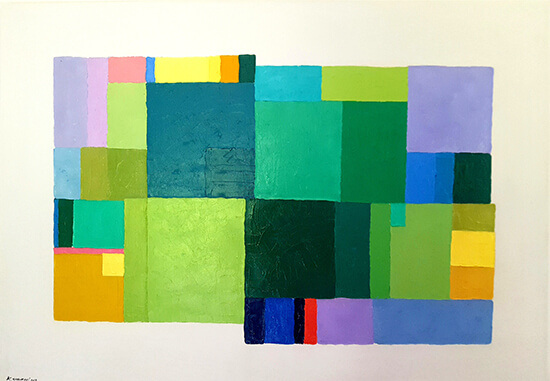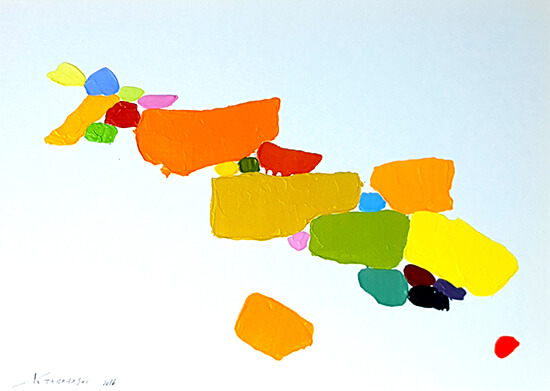I have known Kazuaki TAKAHASHI since the early 2010s. My two daughters were very attracted to the Japanese language and culture, and a mutual friend brought our three families together. Since then, my wife and I have been following and enjoying the paintings of this Japanese artist living in France.
The first impression of his works is one of immense joy, brought on by the symphony of colors. Two of his paintings adorn the walls of our living room, and we admire them every day.

The first, a large-format painting in the style of Au jardin français (2006), is an abstract stylization of the flower-filled garden behind our house. It is a perfect image,like having a mirror on both sides of the big table in our living room. We are now surrounded by multicolored flowers, majestic trees and flowerbeds in infinite shades of green, under an eternally radiant sky. It’s hard to say which of the two, the model or the painting, is brighter, more colorful, more alive. This bucolic painting represents Spring.

The second, smaller painting, in the style of Rythme automnal (2016), represents Autumn. It was inspired by the church of Saint-Martin in Montigny-le-Bretonneux--we can make out the steeple and the centuries-old stone walls, behind the foliage of a variety of majestic trees dressed in the flamboyant colors of the season.
We also have three neo-surrealist lithographs, Paysage en boite (1999), Colonne Morris (2003) and Forêt de Versailles (2010), one in each of our three children's bedrooms.
Beyond these works, I have followed Kazuaki TAKAHASHI's career, from his early neo-impressionist and neo-surrealist works to his more recent and constantly renewed search for abstraction.
If Kazuaki TAKAHASHI’s first, neo-surrealist works remind me of René MAGRITTE, one of my favorite painters, his later, abstract works from 2000 onwards show, in their singularity and strength, the full maturity of the artist. Bright, vivid colors dominate these more recent works, enchanting the eye, stirring the heart and bringing supreme joy to the spirit. At the same time, other works, fewer in number, are very dark but just as powerful. How can we fail to see in them the reflection of the many recesses of the human soul? How can we not be drawn to the spirituality that emanates from all these works, and to which some of the titles discreetly allude? How can we fail to see, behind the abstraction, the infinite wonders of nature on earth?
The titles of Kazuaki TAKAHASHI's paintings are works in themselves. The magic of words resonates with the shapes and colors to fully express sensations, impressions, emotions, rhythms and harmonies. Might the painter also be a poet?
Kazuaki TAKAHASHI is naturally strongly inspired by Japanese art, and the unfinished character of the edges of his paintings is one of the most obvious manifestations of this. But as I contemplate his works, I can't help thinking of the etymological Greek meaning of poetry: a creation, with its figures, rhythm and language, and of enthusiasm, that emotion aroused by a divine transport. Bridging the gap between Asia and the West, Kazuaki TAKAHASHI's paintings resonate deeply within us all.
Daniel Bokobza
Voisins-le-Bretonneux (Yvelines), 2024

